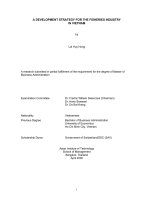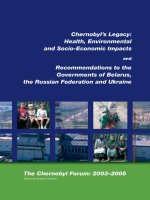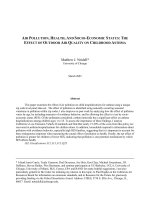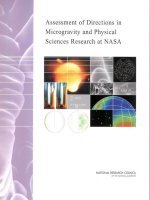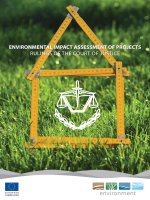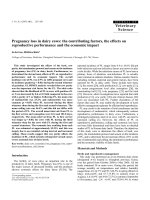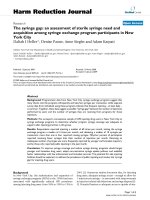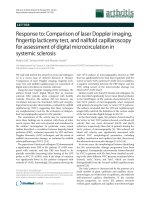Environmental and socio economic impact assessment of urbanization in sta rosa city, philippines
Bạn đang xem bản rút gọn của tài liệu. Xem và tải ngay bản đầy đủ của tài liệu tại đây (1.89 MB, 72 trang )
THAI NGUYEN UNIVERSITY
UNIVERSITY OF AGRICULTURE AND FORESTRY
MARY JOY CAMARGO ONGKIATCO
ENVIRONMENTAL AND SOCIO-ECONOMIC
IMPACT ASSESSMENT OF URBANIZATION
IN STA. ROSA CITY, PHILIPPINES
BACHELOR THESIS
Study Mode: Full-time
Major:
Environmental Science and Management
Faculty:
Advanced Education Program Office
Batch:
2015-2018
Thai Nguyen, 15/11/2018
DOCUMENTATION PAGE WITH ABSTRACT
Thai Nguyen University of Agriculture and Forestry
Degree Program
Bachelor of Environmental Science and Management
Student Name
Mary Joy C. Ongkiatco
Student ID
DTN1454290105
Thesis Title
Environmental and Socio-Economic Impact Assessment of
Urbanization in Sta. Rosa City, Philippines
Supervisor(s)
Prof. Damasa Magcale-Macandog (Institute of Biological
Sciences, University of the Philippines, Los Baños)
Dr. Hồ Ngọc Sơn (Thai Nguyen University of Agriculture
and Forestry)
Supervisor’s
signature(s)
Abstract:
This study focuses on determining the impacts of urbanization on land use/land
cover modifications (1993-2017), total waste generation (2015), air quality (2017),
population and population growth (1990-2015), and economic status (1980-2013)
of Sta. Rosa City, Philippines. Landsat images of 1993, 2005, and 2017 were used
in order to estimate the rate and extent of urbanization within the 24-year period and
to produce land use/land cover change map. It was observed that the built-up land
use of Sta. Rosa City in 2017 increased to 38.52% or 1,834.69 Ha. This was
paralleled by a corresponding decline of agricultural land use. Moreover, it was
observed that the increase of population has resulted to increased total waste
generation of the city in 2015. It was also found out that PM 2.5 annual mean
concentration amounting to 34.12 µ𝑔/𝑁𝑚3 in 2017 exceeded the US EPA guideline
value by 19.13µ𝑔/𝑁𝑚3 . Ambient air concentration of finer air pollutants (PM 2.5)
is strongly negatively correlated with wind velocity. Majority of the working
population is employed in commercial sector and least in agricultural sector. Results
of this study will be useful for future urban development.
Keywords:
Number of pages:
Date of submission:
Urbanization, Land Cover/Land Use Change,
Environmental, Socio-economic, Impact Assessment
62
15/11/2018
ii
ACKNOWLEDGEMENT
I am extending an overwhelming gratitude first to my thesis supervisor, Prof.
Dr. Damasa Macandog, from Institute of Biological Science, University of the
Philippines at Los Banos (UPLB) for the guidance, encouragement, understanding,
patience, and knowledge which greatly contributed to this research. Her suggestions
and constructive criticisms from the research topic to the research manuscript have
manifested, and her influence will never be forgotten. I am thankful to Mr. Donald
Luna for always answering my inquiries and for always imparting knowledge and
assistance especially in mapping activities. I am also thankful to everyone at
Ecoinformatics Lab for the warm welcome and the kindness they have shown. Also,
to my second thesis supervisor, Dr. Hồ Ngọc Sơn, deputy dean from Thai Nguyen
University of Agriculture and Forestry, for the supervision, patience, and knowledge
that he contributed from beginning to the end of this research.
To Ms. Vanessa Bernadette B. Atienza from the Environmental Management
Bureau - Department of Environment and Natural Resources, Region IV-A
CALABARZON office, Ma’am Linda Creencio and Sir Pots F. Ramos from City
Environment and Natural Resources Office for the accommodation and the effort of
providing all of the available data that I needed for this research.
To Dr. Mariano L. Macaleng Jr. (Sir Macaleng), the administrator of my
dearest alma mater – The Refiner’s Christian School, for being one of the pioneers of
the acquired opportunity to study full-time and with full scholarship at Thai Nguyen
University of Agriculture and Forestry under Advanced Education Program. Truly,
TRCS have a great influence in the lives of their students.
To my family, thank you for the support right from the start of this journey, for
letting yourselves as an outlet of inevitable frustrations, and for not giving up on me.
To my spiritual family – Word International Ministries Calauan/Bay outreach, for
making an atmosphere of a true family, for the unceasing prayers, and for the
unending guidance towards growth and maturity. To Alessandra, Joshua, Tonio, Ate
Joice, Niecer, King, JD, Lian, Ghia, Luis, Jess, Pau, Lester, Aj, Enzo, Vea, Tinay,
Fritz, Ate Kat, Ate Rosette, Ate Tina, Kuya JM, family friends from Victoria, and to
all the acquaintances and friends I’ve met who helped throughout this journey, thank
you for showing different sorts of support.
Above and utmost of all, I am extending my deepest gratitude to the Most High,
Jehovah Shalom, Prince of Peace, for being the most stable and everlasting support
system throughout this phase of my life. He worked everything together for good
throughout this research and I can’t thank Him enough for it. His grace is always
sufficient for my weaknesses.
- MJCO
iii
TABLE OF CONTENTS
LIST OF FIGURES .................................................................................................... vi
LIST OF TABLES .................................................................................................... vii
LIST OF ABBREVIATIONS .................................................................................. viii
PART I. INTRODUCTION ........................................................................................ 1
1.1.
Research Rationale ......................................................................................... 1
1.2.
Research Objectives ....................................................................................... 5
1.3.
Statement of the Problem ............................................................................... 5
1.4.
Significance and Limitations of the Study ..................................................... 7
1.5 Definition of Terms ............................................................................................ 9
PART II: LITERATURE REVIEW .......................................................................... 10
2.1. Urbanization and Land Use/ Land Cover Change .......................................... 10
2.2. Impacts of Urbanization to Environment and People ..................................... 11
2.2.1. Urbanization and Waste Generation ............................................................ 13
2.2.2 Urbanization and Air Quality ........................................................................ 14
2.3. Remote Sensing and Geographic Information System ................................... 16
PART III: MATERIALS AND METHODS ............................................................. 18
3.1 Materials ........................................................................................................... 18
3.1.1 The objects of the research ............................................................................ 18
3.2 Conceptual Framework .................................................................................... 18
3.3 Land Use/ Land Cover Change Mapping ........................................................ 20
3.3.1 Data Collection.............................................................................................. 20
3.3.2 Image Pre-Processing .................................................................................... 21
3.3.2.1 Radiometric Calibration ............................................................................. 21
3.3.2.3 Image Subset .............................................................................................. 23
3.3.3 Image Classification ...................................................................................... 24
iv
3.3.4 Accuracy Assessment ................................................................................... 26
3.3.4.1 User’s Accuracy ......................................................................................... 26
3.3.4.2 Producer’s Accuracy .................................................................................. 26
3.3.4.3 Overall Accuracy ....................................................................................... 27
3.3.4.4 Cohen Kappa’s Coefficient ........................................................................ 27
3.3.5 Change Detection Analysis ........................................................................... 28
PART IV. RESULTS AND DISCUSSION .............................................................. 30
4.1 Results of Land Use/Land Cover Change Detection Analysis of Sta. Rosa City
................................................................................................................................ 30
4.2 Total Waste Generation and Waste Composition of Household and NonHousehold Sources ................................................................................................. 35
4.2.2 Particulate Matter (PM 2.5 and PM 10) Concentration of Sta. Rosa City .... 41
4.2.3 Population and Population Change, and Economic Activity of Sta. Rosa City
................................................................................................................................ 45
PART V. CONCLUSION ......................................................................................... 49
REFERENCES .......................................................................................................... 51
APPENDICES ........................................................................................................... 59
v
LIST OF FIGURES
Figure 1: Map of Sta. Rosa City Divided Into Eighteen Barangays ...................................... 4
Figure 2: Conceptual Framework of Land Use/ Land Cover Change Analysis ................... 19
Figure 3: Conceptual Framework for Spatial Maps ............................................................. 20
Figure 4: Pre-processed Images of (a) 1993, (b) 2005, (c) 2017 in Natural Color
Combination (Bands 321 for Images a and b; Bands 432 for Image c ................................. 22
Figure 5: Clipped Images of the Study Area - Santa Rosa City for years 1993, 2005 and
2017 ...................................................................................................................................... 23
Figure 6(a) and (b): False color composite (FCC) and Normalized Difference Vegetation
Index (NDVI) for 1993, 2005, and 2017 Images ................................................................. 25
Figure 7: Land Use/Land Cover Classification of Sta. Rosa City in 1993, 2005, and 2017 31
Figure 8: Land Use/ Land Cover Change Map of Sta. Rosa City from 1993-2017 ............. 34
Figure 9: Composition of Total Waste Generation from Household Sources of Sta. Rosa
City in 2015 Presented in Percent ........................................................................................ 37
Figure 10(a) and (b): Choropleth maps of Total Waste Generation and Population of Sta.
Rosa City in 2015 ................................................................................................................. 37
Figure 11: Associated Choropleth Maps of Total Waste Generation and Population of Sta.
Rosa City in 2015 ................................................................................................................. 38
Figure 12: Scatter Plot Showing the Correlation between Population and Total Waste
Generation ............................................................................................................................ 39
Figure 13: Monthly Average of PM 2.5 and PM 10 Concentrations in Sta. Rosa City in
2017 expressed in micrograms per cubic meter ................................................................... 42
Figure 14: Scatterplot Showing the Monthly Average of PM 2.5 and Wind Speed of Sta.
Rosa City in 2017 ................................................................................................................. 43
Figure 15: Comparison of Annual Means of Guideline Values (from NAAQGV and US
EPA and Sta. Rosa City’s PM 2.5 and PM 10 Concentration Values in 2017 ..................... 44
Figure 16: Population of Sta. Rosa City from 1990-2015 .................................................... 45
vi
LIST OF TABLES
Table 1: Collected Satellite Images and their Attributes ...................................................... 21
Table 2: Description of the Land Use/Land Cover Classification Used in the Study .......... 30
Table 3: Land Use/Land Cover Change Statistics of Sta. Rosa City from 1993-2017 ........ 32
Table 4: Changes of Sta. Rosa City from 1993-2017 Presented in Percent ......................... 33
Table 5:Rate and Extent of LULC from 1993-2017............................................................. 35
Table 6: Total Waste Generation, Waste Composition, and Population of Each Barangay in
2015 ...................................................................................................................................... 36
Table 7: Population, Total Waste Generation, and Per Capita Generation of Sta. Rosa City
in 2015 .................................................................................................................................. 38
Table 8: Total Waste Generation of Non-Household Sources of Sta. Rosa City in 2015 .... 40
Table 9: Monthly Average of Wind Speed and PM 2.5 Concentration of Sta. Rosa City in
2017 ...................................................................................................................................... 43
Table 10: Number of Commercial and Industrial Establishments in Sta. Rosa City from
1980-2013 ............................................................................................................................. 46
Table 11: Intercensal Estimates of Sta. Rosa City’s Employment Status in Various Sectors
of Economic Activity ........................................................................................................... 47
Table 12: Total Number and Rates of Registered Job Applicants and Qualified Job .......... 48
vii
LIST OF ABBREVIATIONS
CALABARZON
Cavite, Laguna, Batangas, Rizal, Quezon
CENRO
DENR
DN
DOS
EMB
ENVI
City Environment and Natural Resources
Department of Environment and Natural Resources
Digital Numbers
Dark Object Subtraction
Environmental Management Bureau
Environment for Visualizing Images (image processing
software; Research Systems, Inc.)
Fast Line-of-sight Atmospheric Analysis of Hypercubes
Geographic Information System
Land Use/Land Cover
Land Use/Land Cover Change
National Ambient Air Quality Guideline Value
National Aeronautics and Space Administration
Operational Land Imager and Thermal Infrared Sensor
Particulate Matter
Philippine Statistics Authority
Remote Sensing
Santa Rosa City
Southern Luzon Expressway
Thematic Mapper
Top-of-atmosphere
Total Waste Generation
United States Environmental Protection Agency
United States Geological Survey
United States Geological Survey Earth Explorer
Waste Analysis and Characterization Study
FLAASH
GIS
LULC
LULCC
NAAQGV
NASA
OLI/TIRS
PM
PSA
RS
Sta. Rosa City
SLEX
TM
TOA
TWG
US EPA
USGS
USGS EE
WACS
viii
PART I. INTRODUCTION
1.1.
Research Rationale
The concept of urbanization started about ten thousand years ago when hunter-
gatherers eventually learned early farming techniques which led to the expansion of
semi-permanent settlements instead of moving to different places to search for food.
As territories enlarged and trade occurred, more people were drawn in and out the
center of trades because of more labor or job opportunities. Urbanization is not
considered as a mere modern phenomenon, but through time, urbanization became
dynamic by the advancement of technology to what is evident today, the modern cities
(Kite, 2013).
Urbanization is mainly attributed to demographic and structural changes. It has
implications other than conversion of lands from rural to urban or from non-built-up
to built-up, but it is a complex process that changes economic, social, technological,
demographic, political and environmental aspects of a community (Stelter & Artibise,
2006). Mostly, urbanization results to urban areas with high density of human
population and infrastructures such as railways, skyscrapers and establishments which
are central to residential, commercial and industrial activities and almost no
agricultural activities exist (National Geographic Society, 2011). By 2030, it is
predicted that about 60% of global population will live in urban areas (Yadav, 2017).
It was reported by the World Bank Group in 2017 that Philippines is one of the fastest
urbanizing countries in the East Asia and Pacific region. About 50 million Filipinos
1
live in urban areas and in 2050 it is predicted to double at 102 million. The increasing
demand for more land to be converted for residential, commercial, and industrial uses
and services cannot be overlooked and it becomes inevitable. The continuous
alteration of land use/land cover amplifies environmental degradation such as too
much generation of wastes and air pollution.
Sta. Rosa City is selected as the study area for it is the “fastest growth center”
of the country located at the region of South Luzon, one of the most sub-dynamic
regions in the Philippines today ( It is a first class component city in the province of Laguna that has a
total land area of 5,543 ha, and lies at 40 kilometers south of Manila, the country’s
capital. Sta. Rosa City is one of the municipalities surrounding Laguna Lake – the
largest lake in the Philippines (LLDA, n.d.). It is bounded by Biñan on the northwest,
Cabuyao on the southwest, Cavite on the west and Laguna de Bay on the northeast.
It became a first-class municipality in 1993 and officially became a city in 2004 which
was
considered
as
an
economic
success
( The city has now evolved into
a major residential, industrial, and commercial center. Figure 1 shows the location of
the study area.
Monitoring of land use/land cover change, efficient and effective detection,
and analytical techniques are essential to urban planners especially at the local and
regional scale in order to assess the patterns and trends of urbanization (Mundhe &
2
Jaybhaye, 2014). Sta. Rosa City is a well-researched place and there are many existing
studies about impacts of urbanization such as flooding. This study would be able to
contribute an updated status of the land use/land cover change of the study area as
well as the link to rapid urbanization and its environmental and socio-economic
impacts in terms of waste generation, air pollution, population growth, and economic
status/activities of the city. Hence, in order to assess the impact of urbanization based
on land use/land cover changes (LULCC) that occurred in the last 24 years (19932017), Landsat data were used aided by modern technologies such as Remote Sensing
and Geographic Information System. Secondary data from various sectors were also
used in analyzing waste generation, air quality and understanding other socioeconomic factors in various years (based on the available data).
3
Figure 1: Map of Sta. Rosa City Divided Into Eighteen Barangays
4
1.2.
Research Objectives
The study generally aims to assess the environment and socio-economic
impacts of urbanization in Sta. Rosa City. Specifically it aims to:
1. To estimate the rate and extent of urbanization in Sta. Rosa City from 1993
to 2017;
2. To identify land use/land cover which has undergone major conversion
from 1993 to 2017;
3. To find out significant relation of waste production to urbanization of Sta.
Rosa City;
4. To analyze the occurrence and concentration of PM 2.5 and PM 10 in Sta.
Rosa’s air quality from 2017;
5. To understand the trends of population, migration, and economic
activity/status of Sta. Rosa City
1.3.
Statement of the Problem
Rapid urbanization is seen as one of the most critical issues nowadays because
it may result to unplanned growth or urban sprawl and one major concern related to
this is dramatic land use (LU)/ land cover (LC) changes (Iizuka et al., 2017). It was
stated by Reis in 2008 that land use/ land cover (LULC) alterations especially the
anthropogenic activities negatively affect climate patterns, natural hazard, and socio5
economic factors on a global and local scale. Nevertheless, the City of Santa Rosa
now relishes the status of being residential, commercial, and industrial center in the
region of South Luzon, the most dynamic sub-region in the Philippines today.
Although increasing urbanization rates have beneficial effects in economic
development such as providing job opportunities, and generating higher income; rapid
urbanization when left unchecked results to adverse effects such as overcrowding,
excessive conversion of land use/land cover from non-built-up to built-up, increased
generation of wastes, and pollution to name a few.
Hence, the study will be conducted to answer these questions:
1. What is the rate of urbanization in Sta. Rosa City from 1993 to 2017 in
terms of land area conversion?
2. Which land use (forest/trees, agricultural land, and bare land), changed the
most from initial state to a final state of built-up from 1993 to 2017?
3. What is the relationship of total waste generation and population of Sta.
Rosa City in 2015?
4. What are the significant trends of the PM concentration of Sta. Rosa City
in 2017?
5. How did urbanization affect socio-economic factors such as population
growth, population shift, and economic status of Sta. Rosa City?
6
1.4.
Significance and Limitations of the Study
Urbanization and the continuous expansion of urban areas are the results of
plans often focused on development to economically sustain a growing population
which often fail to consider various factors such as climate patterns, natural hazards,
sanitation, etc. (Iizuka et al., 2017). The use of approaches and techniques that
produce certain results aided by remotely sensed data has become notable as it is
difficult to conduct field surveys and other ground data collection approaches in
estimating the changes brought about by urbanization on land use/land cover. Land
use/land cover changes and its adverse impacts will be a major concern in the future
if not monitored, analyzed, and assessed.
Hence, finding out and estimating the current extent and rate of urbanization,
the patterns of major land use/land cover alterations, the significant issues related to
it such as waste generation and air pollution as well as the overview to some socioeconomic factors are important especially to urban planners and policy makers in
formulating future policies and ordinances for the residents of Sta. Rosa City. This
study could also provide baseline information to other researchers who are interested
in this topic.
In mapping land use/land cover change, only free downloadable archive
Landsat satellite data with a resolution of 30 meter by 30 meter and shapefile
(administrative boundary) were used. The study was not able to gather Landsat images
within the same months due to the limiting availability of cloudless data for Sta. Rosa
7
City. Mapping of the rate and extent of urbanization only focused on land use/land
cover and not on the physical characteristics of the features such as residential,
industrial, and commercial buildings, elevation, and characteristics of soil.
In identifying the quantity, main composition, and major sources of solid
wastes generated in Sta. Rosa City, as well as the significant relationship to
urbanization, the study was not able to conduct field survey and only secondary data
of 2015 acquired from the City Environment and Natural Resources were used due to
the distance of the study area, and the amount of time it will take to finish the study.
In assessing the impact of urbanization to Sta. Rosa’s air quality, only two
parameters (PM 2.5 and PM 10) were gathered from only one observation point or
roadside ambient air quality monitoring system in Sta. Rosa City. The data were
gathered from the Department of Natural Resources – Environmental Management
Bureau Regional Office of Region IV-A CALABARZON. Thus, the study only
focused on analyzing the trends of PM 2.5 and PM 10 occurrence in 2017 instead of
the proposed preparation of air quality index map of Sta. Rosa City. In understanding
the trends of socio-economic factors: population, migration, and employment status
of Sta. Rosa City, only those available secondary data/censuses were used.
8
1.5 Definition of Terms
Definition of Terms can be found in Appendix 1.
9
PART II: LITERATURE REVIEW
2.1. Urbanization and Land Use/ Land Cover Change
Currently, 55% of the world’s population lives in urban areas. By 2030, the
population of global urban communities will grow to 4.9 billion. On the other hand,
between 2005 and 2030, the world’s rural population will decrease by 28 million
(Bhatta et al., 2010). Asia, despite its relatively lower level of urbanization, is home
to 54% of the world’s urban population (UN, 2018). In fact, Philippines is one of the
fastest urbanizing countries in the East and Asia Pacific region, with 2-5% of its total
area occupied by cities (World Bank Group, 2017).
Urbanization is defined by the United Nations (UN) as the increase in the
proportion of a population living in urban areas and the process by which cities are
formed as large number of people becomes permanently concentrated on small areas.
It is a global phenomenon that has different expressions within countries and in their
level of development. Richer countries already have a large number of people living
in urban areas while third world countries are still mostly rural but will urbanize faster
than other regions (United Nations, 2018). In addition, urbanization is a physical
transformation of landscapes from natural land covers to developed ones, mostly
impervious surfaces for residential, industrial, and commercial purposes as well as
schools and hospitals (Sharma, 2014).
Land, an irreversible resource is central to primary production systems (Prasad
& Sreenivasulu, 2014). Land cover is the physical characteristics of the surface of the
10
earth whether be it a manmade feature such as housing/settlements or a natural feature
such as vegetation, water bodies and soil. Land use is the human activity that is being
done on the feature of the earth’s surface which is the land cover (Rawat & Kumar,
2015). Land use and land cover are terms that are always correlated and often used
interchangeably because land cover is the direct result of land use. Generally, LULCC
is a term that refers to the human modification of Earth's terrestrial surface (EngayGutierrez, 2015). Land use and land cover are considered as essential elements in
understanding the earth as a system which is important for planning and management
activities (Lillesand & Kiefer, 2000). They are regarded as important factors in
assessing environmental issues, population shift, and economic conditions (DeFries,
2012).
2.2. Impacts of Urbanization to Environment and People
Land use/ land cover changes are the major issues and challenges to the three
dimensions of sustainable development: economic, social and environmental (Rawat
et al., 2013; United Nations, 2018). According to Wu (2008), land use/ land cover
change is arguably the most extensive force that causes degradation of the
environment. Rawat et al. in 2013 stated that land use/ land cover change could be
beneficial if every available land is used correctly for economic improvement. Rapid
urbanization and city expansion are driven by the pressure of an ever growing
population and the increase of economic activities for sustaining the needs of the
population which has benefits for economic development. However, factors such as
climate patterns, natural hazards, sanitation, etc. were often overlooked when
11
expanding cities which eventually leads to land, air, and water pollution, traffic
congestion, overcrowding, increased temperature, diseases, etc.
The transition of land uses/land covers of Sta. Rosa City has been dramatic
since the year 1946 but most notably in 1990 when built-up areas started to boom and
are continuously increasing, while agricultural lands are continuously decreasing. The
change in land uses/land covers of the city has also influenced the change in the main
sources of livelihood. Historically, a large proportion of the city were devoted to
agricultural lands in 1946 when large number of farmers were still able to grow and
produce crops such as rice, corn, coffee, sugarcane, and fruit-bearing trees. Residents
were also living off livestock like poultry and piggery and fishing was an option too
for those who live in/near the lakeshore barangays/areas. The opening of South Luzon
Expressway (SLEX) in 1980s has slowly paved way for local and foreign investors
who influence rapid development of the city. Since then, the agricultural lands and
the number of people living off agriculture sector has been decreasing. Sta. Rosa City
has also been consequentially contributing to the unfavorable Class C status of Laguna
Lake ( />Flooding, as intensely experienced in Sta. Rosa City when Typhoon Ondoy hit
in 2009 is one of the impacts of urbanization to environment which is due to large
generation of unmanaged solid wastes by the residential areas along with informal
settlers that clogs canals, waterways, and river banks. Groundwater depletion is also
being experienced which is due to the rising demand of water as economic activities
12
and population are also increasing. Furthermore, the severe use of fertilizers and
pesticides is one of the factors contributing to the declining productivity of Laguna
Lake along with pollution from industries, siltation and sedimentation, encroachment
of shoreline areas, and rapid conversion of prime agricultural lands into industrial and
residential lands. Thus, fish growth and fish harvest were also diminishing due to
pollution (Eugenio, 2018).
2.2.1. Urbanization and Waste Generation
Globally, especially in developing countries, an increasing population,
uncontrolled urbanization and industrialization have greatly increased the rate of
waste generation and its poor disposal and management (Ugwuanyi & Isife, 2012).
Increasing rates of waste generation along with poor disposal and management have
affected the environment and its sustainability which includes: pollution, availability
of space, waste leaching, contamination of ground and surface water, clogged
drainage that intensifies flood during rainy seasons, and diseases such as cholera and
dengue fever also arise due to the attraction of rodent and insect vectors to wastes.
According to U.S. Public Health Service, 22 diseases are found out to be linked to
improper solid waste management (Pervez & Ahmade, 2013). It has been recognized
by the global community that solid waste management requires serious awareness
along with action.
In the Philippines, with the rapid growth of population, waste management has
become a major environmental challenge (Castillo & Otoma, 2013). About 35,580
13
tons of garbage is generated every day in the Philippines. Waste mismanagement in
the Philippines has become prevalent that resulted to the passage of Republic Act
(RA) 9003 or Ecological Solid Waste Management Act of 2000 which is an act
providing for an ecological solid waste management program, creating the necessary
institutional mechanisms and incentives, declaring certain prohibited acts and
providing penalties, and appropriating funds. Solid wastes is defined by Sta. Rosa
City’s Environmental Code (City Ordinance No.1720-2011) as all discarded
household, commercial wastes, non-hazardous institutional and industrial wastes,
street sweepings, construction debris, agricultural wastes, and other nonhazardous/non-toxic solid wastes. According to the City Environment and Natural
Resources Officer, the average individual waste generation or per capita generation
in 2015 is 0.7 per kg/day. The increased generation of solid wastes by high-density
residential areas or informal settlers along with the illegal dumping of wastes to water
ways have contributed to intense flooding in the city (Eugenio, 2018).
2.2.2 Urbanization and Air Quality
Urban development has paved the way for the increase of human-engineered
structures such as buildings, factories, and vehicles that produce smoke which
amplifies air pollution. Air pollution is one of the key environmental problems
associated with urbanization and land use/ land cover change. It was considered that
industrial emissions and vehicle exhausts are the main sources of air pollution. In an
instance, built-up is central for human activities, therefore it directly produces air
14
pollutants to the surrounding environment. There are also land uses that indirectly
emit air pollutants but still attract vehicular sources ((Xu et al., 2016). Air pollutants
include gaseous substances and particulate matter such as PM 2.5 and PM 10.
Particulate matter (PM) also called as particle pollution which includes (PM
2.5 and PM 10) is a major air pollutant in which its concentrations are directly affected
by human activities and the surrounding areas (EPA, 2016; Chan & Yao, 2008).
Particulate Matter is the term for a mixture of solid particles and liquid droplets found
in the air. These particles vary in size, as there are particles that are large or dark
enough to be seen by the naked eye such as dust, dirt, soot, and smoke; while others
are small that are only visible through the use of microscope (EPA, 2016). PM 2.5
which stands for particulate matter 2.5 (with diameters that are 2.5 micrometers and
smaller) are fine particles that generally causes smog and aerosol in high
concentrations (Xing et al., 2016). They can penetrate the lungs and cardiovascular
system (DENR, 2017). On the other hand, PM 10 which stands for particulate matter
10 (with diameters that are 10 micrometers and smaller) are coarse particles that are
produced by all types of combustion, including motor vehicles, power plants,
residential wood burning, forest fires, agricultural burning, and some industrial
processes (AirNow, 2017).
Air pollution is now seen as the leading problem for environmental health risk
with 92% of the world’s population being exposed to areas that exceed World Health
Organization’s ambient air quality guidelines. One out of 4 deaths in the Philippines
15
is attributed to air pollution. Air pollution is one of the key concerns in the physical
environment of Sta. Rosa City. As the number of industries increase and traffic
congestion worsens, a great risk is being faced especially by those who reside near
the industries. The city of Santa Rosa started monitoring ambient air quality in 2016
through the installation of the ambient air monitoring station by the Environmental
Management Bureau (CLUDP, 2000-2015).
Republic Act 8749 requires the monitoring of ambient air quality, the average
purity of the atmosphere in major cities in the country. In order to monitor the ambient
air quality, the Department of Environment and Natural Resources – Environmental
Management Bureau has set-up regional monitoring systems in several major cities in
the country which have different monitoring types and criteria of the pollutant being
monitored. Monitoring types can be general air pollution monitoring systems that is
used for fixed areas or roadside air quality monitoring systems used for assessing air
pollution caused by motor vehicles within large traffic systems.
2.3. Remote Sensing and Geographic Information System
Remote sensing is the science of obtaining information about an object or an
area indirectly or from a distance, by the use of various instruments such as sensors
(NOAA, 2017). Generally when scientists use this term, it means that the use of the
gathered information is primarily to study the earth system and its dynamics
(European Space Agency, 2010). Remote sensing serves as the ‘eye’ providing
repeated and completed remotely sensed images of the earth from an aerial or above16
view point (Lillesand & Kiefer, 2000). Remote Sensing advances in characterizing
spatial (space) and temporal (time) analysis of urban growth’s patterns and processes
rather than causes and consequences by using multi-stage images (Sun, et. al., 2007).
Geographic Information System (GIS) is a system or framework used for collecting,
storing, processing, and modeling all types of geographical data. It helps in indicating
landscape in terms of structure, function, and change (Sudhira, et. al., 2004).
It is through the integration of Remote Sensing (RS) and Geographical
Information System (GIS) that researches on various fields become widely
comprehensible (Vallesteros, 2002). This integration has provided an almost daily
basis improvement for the mapping of land use/cover change which became more
vast, detailed and useful. Most importantly, people become more aware of the
interrelation and fragility of the elements on earth as a system and the role of RS and
GIS integration in acquiring necessary information, processing, managing and
modeling the earth as a system (Lillesand & Kiefer, 2000).
17
